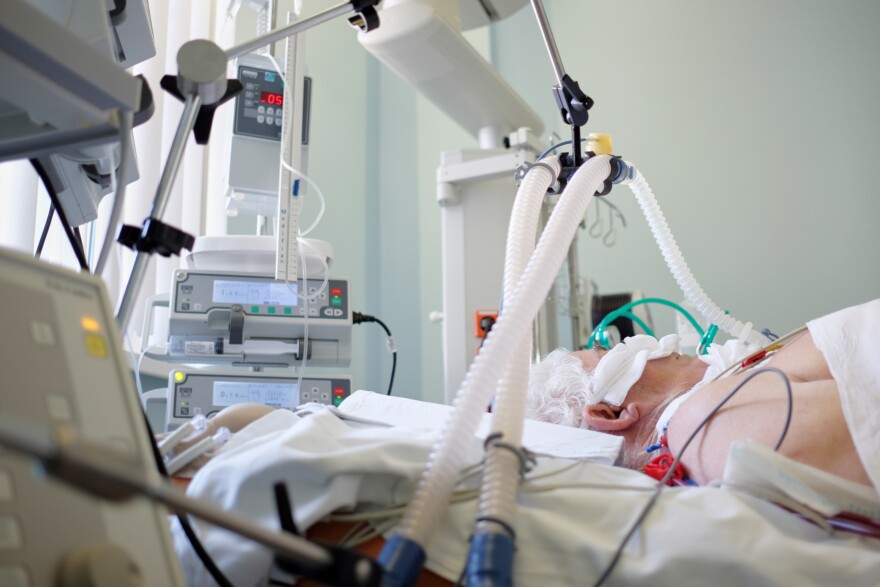At St. Joseph Ann Arbor Mercy hospital, every single one of the 488 staffed adult beds is full.
By early Tuesday afternoon, more than 100 patients are crowded into the Emergency Department, but there are only 70 beds. So they spill over into the hallways, sitting in reclining chairs with IVs in their arms or breathing through portable oxygen machines. Some are laying on stretchers out in the open. One white-haired woman sees a doctor walking past and waves her arms above her head, trying to flag him down.
“Think about having your loved one here,” says Dr. Anurag Malani, who heads up the infectious disease COVID response team at St. Joseph’s. He’s motioning to the patients in the hall. “Would you want that?”
No one would. In the spring of 2020, everyone talked about “flattening the curve” and keeping the health system from getting overwhelmed. But now, in late 2021, experts say the system is completely overwhelmed, with the state seeing the highest daily case count since the pandemic began. Yet unlike Michigan’s previous three surges, this one was preventable.
“It’s absolutely heartbreaking what we are seeing,” says Dr. Rosalie Tocco-Bradley, chief clinical officer for Trinity Health Michigan, which has eight hospitals in the state, including St. Joseph’s. Every one of them is seeing a record number of COVID cases.
“We have actually had to ship ventilators in from other sister hospitals outside the state, because we don’t have enough ventilators to care for all the COVID patients. The nursing staff, the other clinical frontline staff...they are exhausted. They are frustrated. And I would say they are heartbroken, because they are seeing people die who don’t have to die.”
Don’t have to die, because the vast majority could have gotten vaccinated. In Michigan, 87% of hospitalizations and 86% of deaths are among people who aren’t fully vaccinated. And breakthrough hospitalizations are concentrated among older adults with multiple underlying conditions, Malani says.

“I mean, in some ways there's feelings of, you know, there's feelings of sadness. There's also feelings of anger, right? That we're in a situation that, hey, you know, we could be not in this situation. Things don't have to be as bad as they are,” Malani said.
As of Wednesday, nearly 4,500 adults are currently hospitalized for confirmed or suspected COVID, according to state data. More than 85% of all adult ICU beds in Michigan are full.
“The current wave’s hospitalizations have exceeded peaks of the Winter 2020 and Spring 2021 waves and are approaching the Confirmed Positive [cases in the] Spring 2020 wave peak,” a Michigan Department of Health and Human Services epidemiology report released this week stated.
In Michigan, unvaccinated persons have 4.4 times the risk of testing positive for COVID and 9.3 times the risk of dying from it compared to fully vaccinated people, the report said, citing data from September.

“Increased prevention efforts could prevent an estimated 108,000 – 155,000 cases, 11,000 – 16,000 hospitalizations and 1,200 –1,900 deaths over December and January,” according to the state’s report.
When Malani talks to his unvaccinated COVID patients at St. Joseph's, he usually tries to ask why they didn’t get the vaccine. The responses typically fall in a few categories: they didn’t know COVID could be this bad. They didn’t think getting the vaccine was so important. Or they thought the vaccine was potentially dangerous itself.
“I think you realize that whatever sources these individuals are listening to, whatever misinformation and disinformation they're listening to, is it's really powerful,” Malani said. Cleary, he said, having community and health officials repeating the same messages about vaccination aren’t convincing enough people.
“That hasn’t worked,” he said. “And we need to think about the people that we actually are caring for in a hospital, and having them really be the messengers for what things are like. There's no better spokesperson for getting the vaccine than someone that's had COVID, especially going back to maybe a community that has low vaccination rates.”
Because while outside the hospital, it can feel like things are somewhat back to normal, inside the ER, the link between being unvaccinated and being hospitalized for COVID becomes very real.







